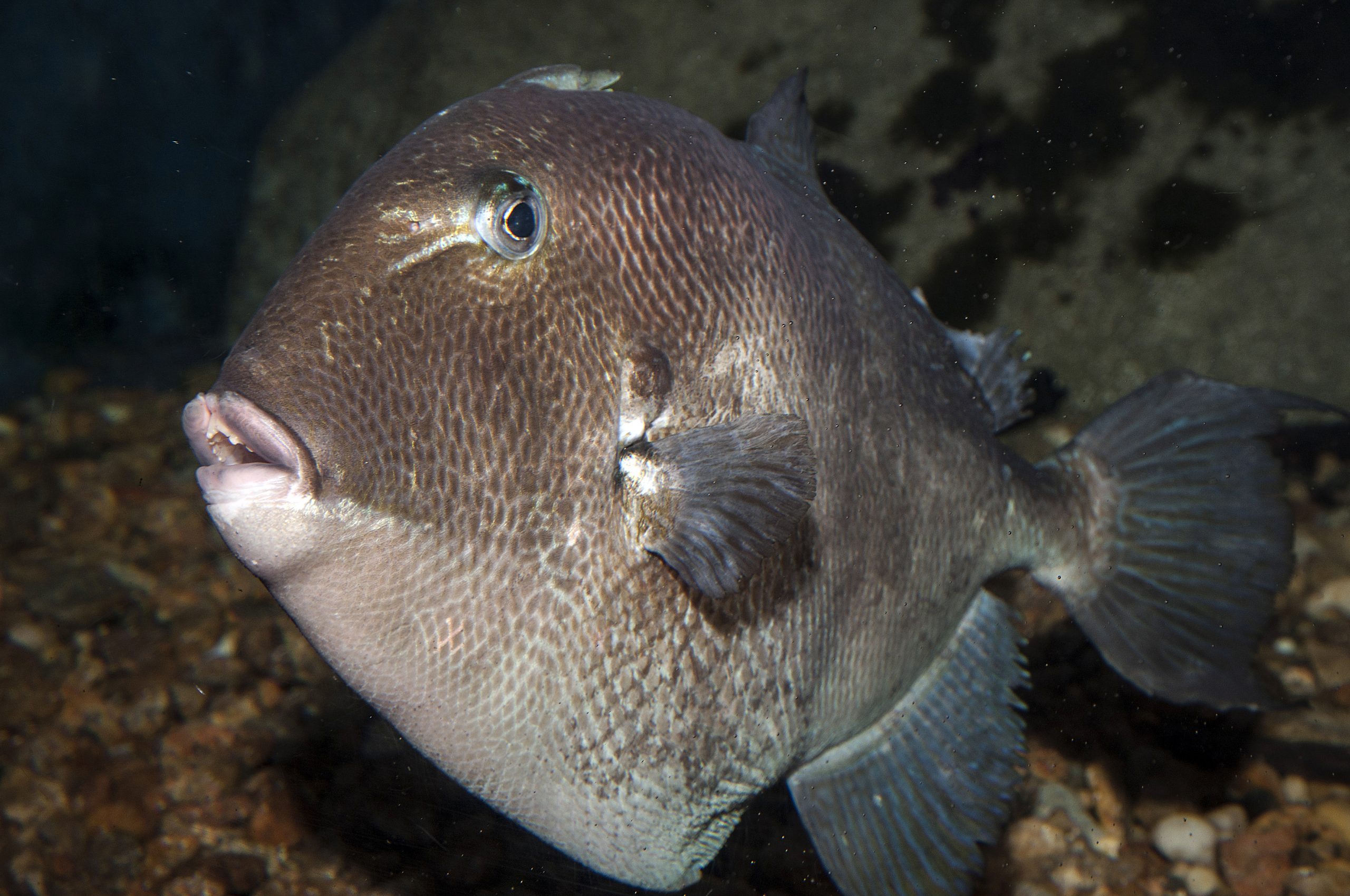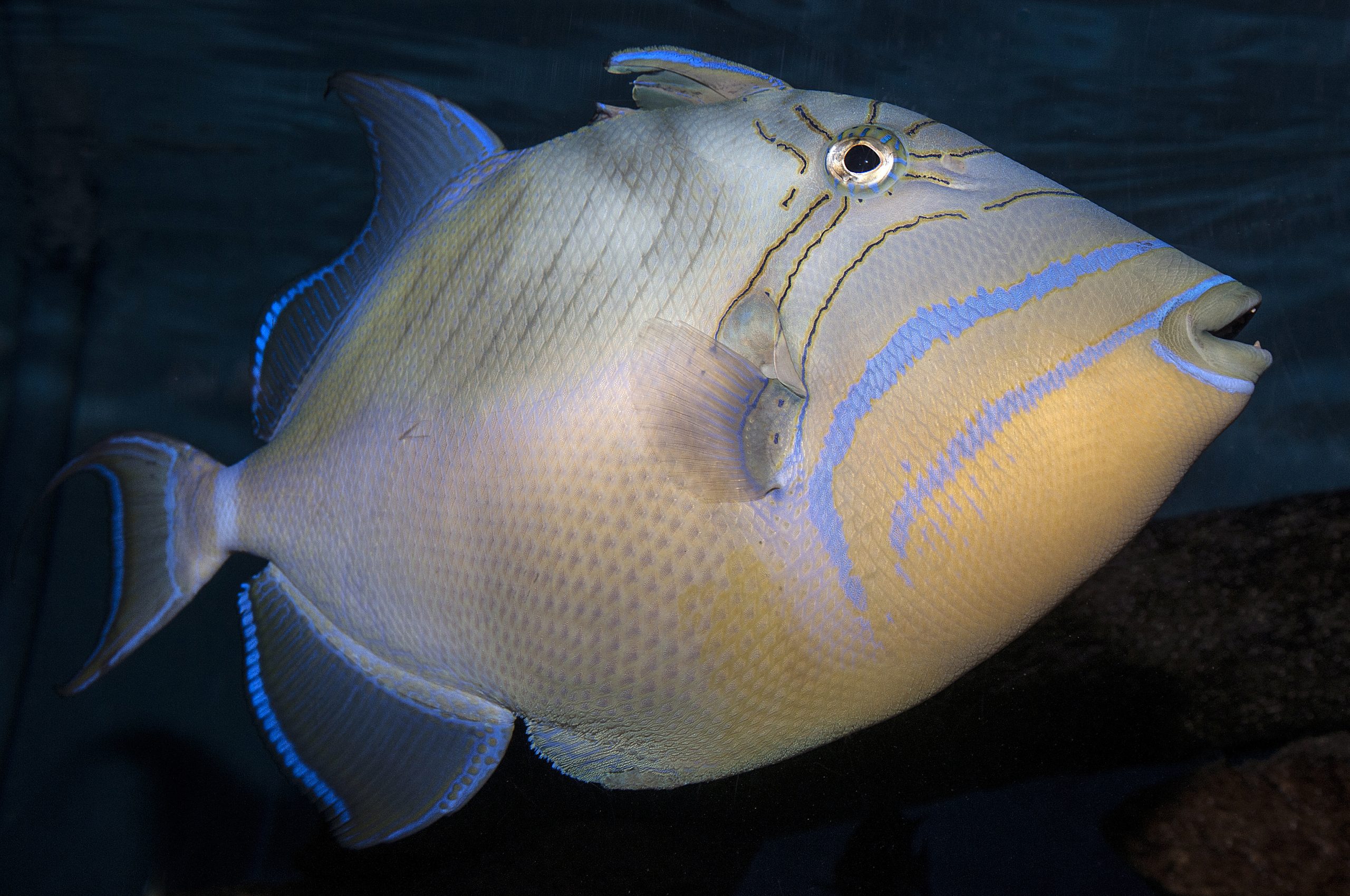
One of the strangest looking and trickiest to catch saltwater fish in North Carolina waters is the triggerfish.
These animals swim by moving their top fin and bottom fins. Flapping them in the “breeze,” they are able to hover in one position. They can also lock themselves in a reef crevice for protection by erecting these same fins and wedging themselves in place. Once the fish release this defense mechanism, they are nearly impossible to get free — also posing a challenge for fishermen once hooked.
Supporter Spotlight
Gray triggerfish are the primary members of this species found in North Carolina waters. They range in the Atlantic Ocean from Nova Scotia south to Argentina. A second population can also be found in the Gulf of Mexico.
Queen triggerfish are the second member of this group caught off the North Carolina coast, but are less frequently encountered by fisherman. They live in depths between 7 and 92 feet in the Caribbean, Bahamas, the Atlantic from Canada to Florida, Bermuda and the Gulf of Mexico, but are more typically caught at depths between 10 and 98 feet.
In North Carolina, the state records are 11 pounds 6 ounces for a gray triggerfish caught off the coast of Morehead City in 1992, and 10 pounds 11 ounces for a queen triggerfish caught in 2012 off Jacksonville.
“Both species live on ocean hard bottoms, reefs and ledges, on shipwrecks, nearshore, and offshore locations, either alone or in small groups, or schools,” said McLean Seward, fisheries biologist with the North Carolina Division of Marine Fisheries.
Both triggerfish species have various nicknames depending upon where they are caught, including taly, leatherjacket, leatherneck, or just plain triggerfish.
Supporter Spotlight
Easy to identify
Adult gray triggerfish are mainly olive-gray in color and have blue spots and lines on the upper body and dorsal fin, and the upper part of their eyes are blue. I have observed this species as primarily a light- to medium-gray in color while scuba diving.
“Adult gray triggerfish can change their color, especially during the spawning season that usually begins in April and will continue through August of each year. Males turn dark charcoal gray, while females who are actively nesting’s colors will be highly variable with contrasting white and black color patterns,” said Seward.
Juvenile triggerfish appear yellowish with violet dots that are usually small but can also have irregular dark patches that can be significantly large on their fins and body.
Juveniles also have saddle markings, and light spots on their dorsal, or top, and anal fins, he said.
“Both the gray and queen triggerfish have large, sharp teeth, and a deep, laterally compressed body covered with tough sandpaper-like skin,” said Seward.
Unlike their cousin, the filefish, which are commonly confused with triggerfish, triggerfish have more than one dorsal spine.

Gray triggerfish are easy to distinguish from queen triggerfish. Whereas grays have a drab coloration, queen triggerfish have a beautiful, rainbow spectrum along their bodies and fins. There is no mistaking the two.
“Gray triggerfish in North Carolina can grow to 30 inches in length and weigh up to 13 pounds, while queen triggerfish grow to maximum lengths of about 24 inches, and up to 12 pounds. Our average queen triggerfish tend to be slightly larger than the gray,” Seward said.
However, queen triggerfish are much less commonly encountered than gray triggerfish in North Carolina, he added.
“Looking at the last 10 years of our commercial fish house data, the average (fork length) for gray triggerfish was 15.3 inches and 18.2 inches for queen triggerfish. Gray triggerfish landed by the recreational fleet had an average fork length of 13.8 inches over the past 10 years. Recreational length frequency data was not available for queen triggerfish,” Seward noted.
Anatomy and life history
Both species share similar habitat, spawning behavior and life history.
“Triggerfish get their name from spines that have been developed on the dorsal fins that can be used as a predator defense and for holding themselves in place on rocky, or coral bottom. The first spine is large, and when upright it remains that way until the fish relaxes the smaller second spine, triggering the first,” said Seward.
“When a triggerfish feels threatened it will dive into a tight, confined space such as a crevice and anchor itself into place by locking its’ ‘trigger’ spine,” he said.
Gray triggerfish can live to be 16 years old. Male triggerfish are usually bigger than females. All triggerfish will grow to be sexually mature by the time they reach 2 years of age.
Spawning takes place between April and August of each year. Males establish home territories, build their nests in the sand and coax females into the nest to spawn. The two swim tight circles around one another in the nest, quickly changing color. As the female lays her clutch of eggs in the nest immediately after the circling behavior, the male fertilizes the eggs with his milt, or sperm.
The spawning behaviors of triggerfish closely resemble that of a freshwater bass, including smallmouth and largemouth bass.
The males of both triggerfish species will establish territories of up to 33 feet in diameter and will attract several females. Spawning behaviors are the same for both species.
Triggerfish in North Carolina will voraciously defend their nests and eggs, even biting scuba divers who venture too close to their brood of eggs.
Female gray triggerfish can lay an average of 772,415 eggs.
After fertilization, females aerate the eggs by fanning and blowing on them until they hatch.
It is possible for a single male triggerfish to defend up to three active nest sites on the same reef. One female on a nest, guarding and providing oxygen to her eggs, is referred to as an active nest location. The female will also protect her unhatched young from predators that may include wrasse, grouper and snapper.
After 24-48 hours of the female caring for her eggs, they will hatch-out into larvae, which float to the surface where they frequently live among mats of sargassum.
Larvae and juveniles will live for between 4-7 months in the sargassum before they move to the ocean floor and grow into adulthood.
Underwater helicopter, hard to catch
“Both species of triggerfish use their dorsal and anal fins to go up and down in the water column and hover like a helicopter while searching for food below. They use their powerful jaws with incisor-like teeth to chisel holes and loosen and crush hard-shell prey that may include lobsters, crab, shellfish, shrimp and sea urchins,” said Seward.
Both gray and queen triggerfish get creative while hunting for food and sometimes direct a stream of water over the sandy ocean bottom to uncover sand dollars in order to eat them.
“Juvenile triggerfish eat barnacles, hydroids and many types of small worm species,” Seward said.
Shark, grouper and amberjack feed upon adult triggerfish, while marlin, dolphinfish, tuna, sailfish and shark prey upon smaller triggerfish.
Catching triggerfish is tricky with hook and line because they nibble and do not strike at bait. Bottom fishing for other reef fish species is usually the way anglers incidentally catch them.
Commercial fishing of this species is managed under a split season: The annual catch limit is divided with half available Jan. 1 through June 30 and half available July 1 through Dec. 31 each year, said Steve Poland, fisheries biologist and executive assistant for council with the Division of Marine Fisheries.
Each season remains open until the seasonal quota has been met or is projected to be met. Any leftover quota from the first season will roll in to the second season. Commercial fishermen are required to possess a limited access permit. The minimum size is 12-inch fork length and the trip limit is 1,000 pounds whole weight.
“The new recreational bag limit for gray triggerfish is now 10 fish per day. This is down from 20 fish per day prior to March of 2020,” said Poland.
There is currently no regulation for daily take of queen triggerfish but don’t clean them at sea.
“All triggerfish are required to be landed with fins and head intact. Recreational and commercial fishermen are required to use de-hooking tools when fishing for any snapper/grouper species, which includes triggerfish,” said Poland.
Fishing with non-stainless-steel circle hooks, either offset or non-offset, is required for all species in the snapper/grouper complex when using hook-and-line gear with natural baits in waters north of 28 degrees latitude.
“After the commercial quota has been met, all purchase and sale are prohibited, and harvest and/or possession is limited to the recreational bag limit while recreational harvest is open. This prohibition does not apply to fish harvested, landed and sold before the quota was reached and held in cold storage by a dealer,” Poland said.
Charter and head boats and commercial snapper/grouper vessels are required to have with them National Marine Fisheries Service-approved sea turtle release gear and follow smalltooth sawfish release protocols.
Scuba diving or snorkeling with spearfishing gear without re-breathers is an allowed method of fishing for triggerfish. Rod and reel fishing gear that is allowed includes vertical hook-and-line, hand-held hook-and-line and bandit gear.







